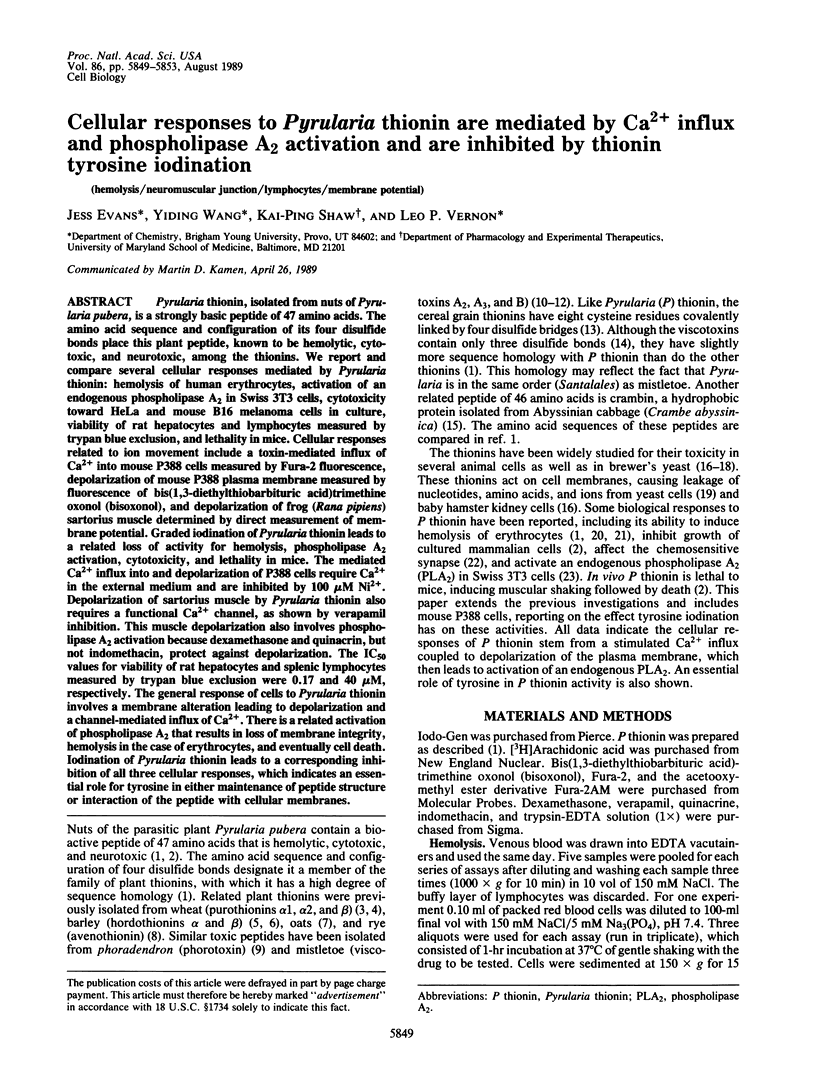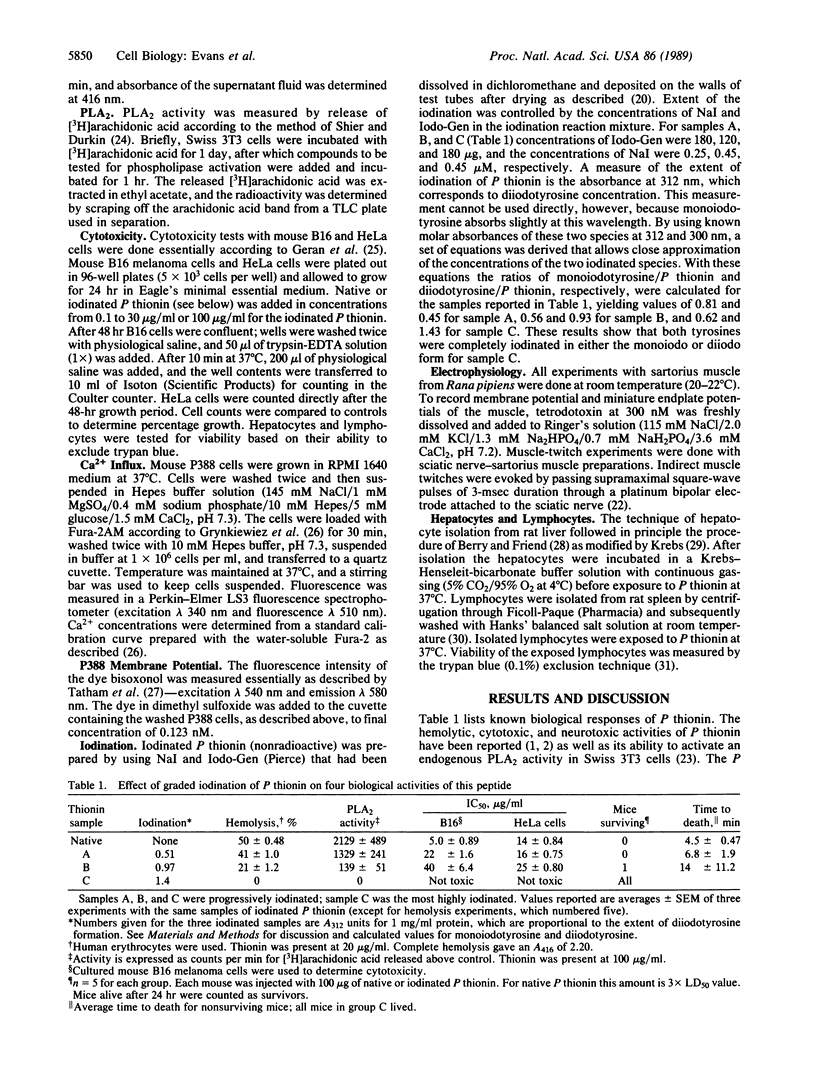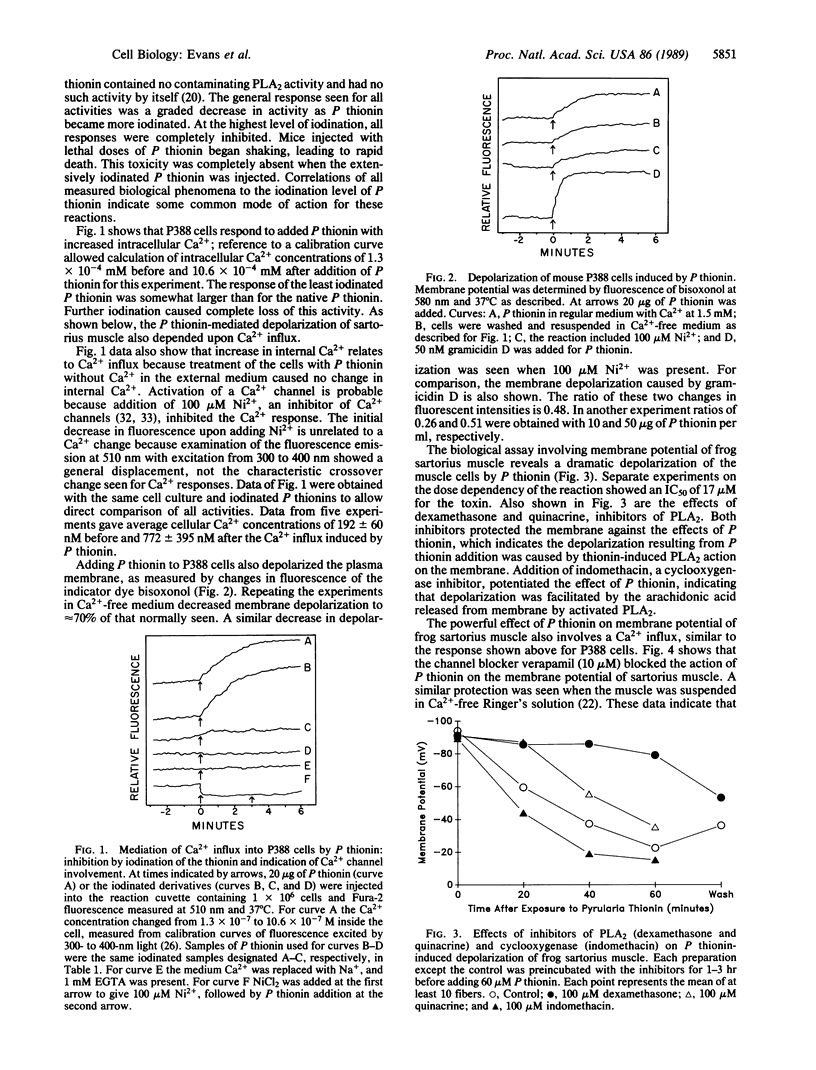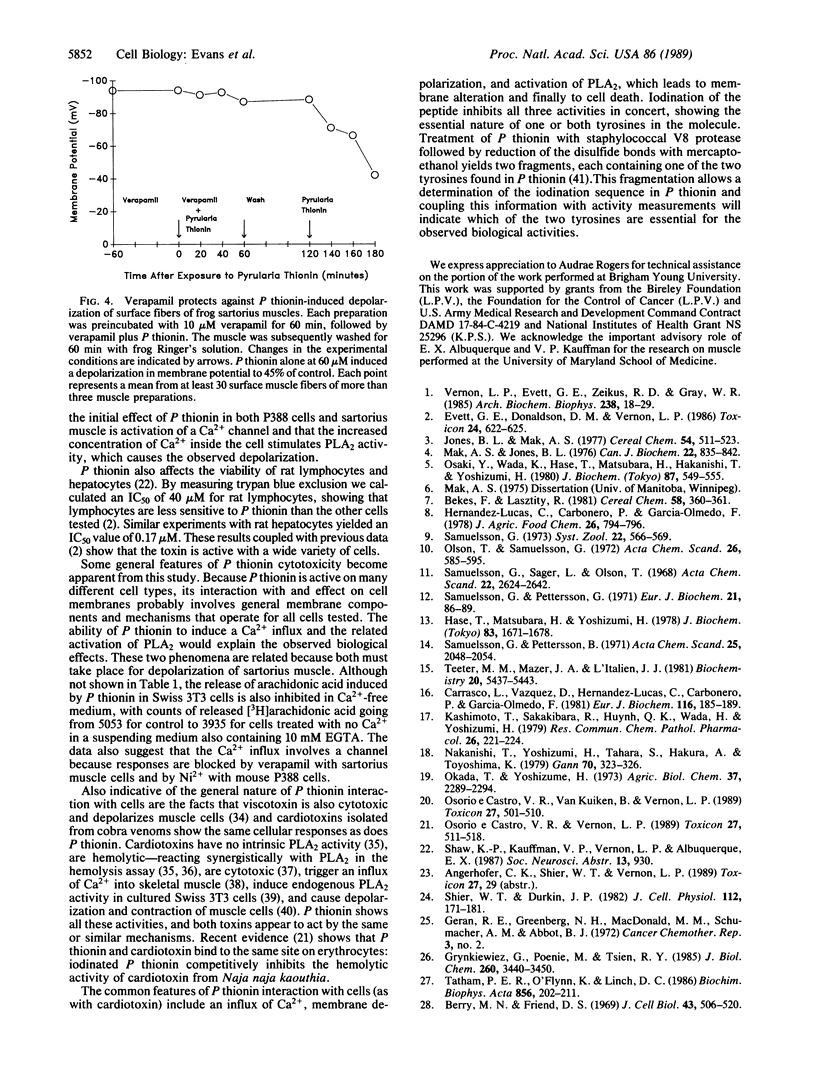Abstract
Pyrularia thionin, isolated from nuts of Pyrularia pubera, is a strongly basic peptide of 47 amino acids. The amino acid sequence and configuration of its four disulfide bonds place this plant peptide, known to be hemolytic, cytotoxic, and neurotoxic, among the thionins. We report and compare several cellular responses mediated by Pyrularia thionin: hemolysis of human erythrocytes, activation of an endogenous phospholipase A2 in Swiss 3T3 cells, cytotoxicity toward HeLa and mouse B16 melanoma cells in culture, viability of rat hepatocytes and lymphocytes measured by trypan blue exclusion, and lethality in mice. Cellular responses related to ion movement include a toxin-mediated influx of Ca2+ into mouse P388 cells measured by Fura-2 fluorescence, depolarization of mouse P388 plasma membrane measured by fluorescence of bis(1,3-diethylthiobarbituric acid)trimethine oxonol (bisoxonol), and depolarization of frog (Rana pipiens) sartorius muscle determined by direct measurement of membrane potential. Graded iodination of Pyrularia thionin leads to a related loss of activity for hemolysis, phospholipase A2 activation, cytotoxicity, and lethality in mice. The mediated Ca2+ influx into and depolarization of P388 cells require Ca2+ in the external medium and are inhibited by 100 microM Ni2+. Depolarization of sartorius muscle by Pyrularia thionin also requires a functional Ca2+ channel, as shown by verapamil inhibition. This muscle depolarization also involves phospholipase A2 activation because dexamethasone and quinacrin, but not indomethacin, protect against depolarization. The IC50 values for viability of rat hepatocytes and splenic lymphocytes measured by trypan blue exclusion were 0.17 and 40 microM, respectively. The general response of cells to Pyrularia thionin involves a membrane alteration leading to depolarization and a channel-mediated influx of Ca2+. There is a related activation of phospholipase A2 that results in loss of membrane integrity, hemolysis in the case of erythrocytes, and eventually cell death. Iodination of Pyrularia thionin leads to a corresponding inhibition of all three cellular responses, which indicates an essential role for tyrosine in either maintenance of peptide structure or interaction of the peptide with cellular membranes.
Full text
PDF




Selected References
These references are in PubMed. This may not be the complete list of references from this article.
- Andersson K. E., Jóhannsson M. Effects of viscotoxin on rabbit heart and aorta, and on frog skeletal muscle. Eur J Pharmacol. 1973 Sep;23(3):223–231. doi: 10.1016/0014-2999(73)90087-3. [DOI] [PubMed] [Google Scholar]
- Berry M. N., Friend D. S. High-yield preparation of isolated rat liver parenchymal cells: a biochemical and fine structural study. J Cell Biol. 1969 Dec;43(3):506–520. doi: 10.1083/jcb.43.3.506. [DOI] [PMC free article] [PubMed] [Google Scholar]
- Carrasco L., Vázquez D., Hernández-Lucas C., Carbonero P., García-Olmedo F. Thionins: plant peptides that modify membrane permeability in cultured mammalian cells. Eur J Biochem. 1981 May;116(1):185–189. doi: 10.1111/j.1432-1033.1981.tb05317.x. [DOI] [PubMed] [Google Scholar]
- Dufton M. J., Hider R. C. Structure and pharmacology of elapid cytotoxins. Pharmacol Ther. 1988;36(1):1–40. doi: 10.1016/0163-7258(88)90111-8. [DOI] [PubMed] [Google Scholar]
- Evett G. E., Donaldson D. M., Vernon L. P. Biological properties of Pyrularia thionin prepared from nuts of Pyrularia pubera. Toxicon. 1986;24(6):622–625. doi: 10.1016/0041-0101(86)90185-6. [DOI] [PubMed] [Google Scholar]
- Grynkiewicz G., Poenie M., Tsien R. Y. A new generation of Ca2+ indicators with greatly improved fluorescence properties. J Biol Chem. 1985 Mar 25;260(6):3440–3450. [PubMed] [Google Scholar]
- Harvey A. L., Hider R. C., Khader F. Effect of phospholipase A on actions of cobra venom cardiotoxins on erythrocytes and skeletal muscle. Biochim Biophys Acta. 1983 Feb;728(2):215–221. doi: 10.1016/0005-2736(83)90474-1. [DOI] [PubMed] [Google Scholar]
- Harvey A. L., Marshall R. J., Karlsson E. Effects of purified cardiotoxins from the Thailand cobra (Naja naja siamensis) on isolated skeletal and cardiac muscle preparations. Toxicon. 1982;20(2):379–396. doi: 10.1016/0041-0101(82)90001-0. [DOI] [PubMed] [Google Scholar]
- Hase T., Matsubara H., Yoshizumi H. Disulfide bonds of purothionine, a lethal toxin for yeasts. J Biochem. 1978 Jun;83(6):1671–1678. doi: 10.1093/oxfordjournals.jbchem.a132079. [DOI] [PubMed] [Google Scholar]
- Kashimoto T., Sakakibara R., Huynh Q. K., Wada H., Yoshizumi H. The effect of purothionin on bovine adrenal medullary cells. Res Commun Chem Pathol Pharmacol. 1979 Oct;26(1):221–224. [PubMed] [Google Scholar]
- Lin Shiau S. Y., Huang M. C., Lee C. Y. Mechanism of action of cobra cardiotoxin in the skeletal muscle. J Pharmacol Exp Ther. 1976 Mar;196(3):758–770. [PubMed] [Google Scholar]
- Louw A. I., Visser L. The synergism of cardiotoxin and phospholipase A2 in hemolysis. Biochim Biophys Acta. 1978 Sep 11;512(1):163–171. doi: 10.1016/0005-2736(78)90227-4. [DOI] [PubMed] [Google Scholar]
- Mak A. S., Jones B. L. The amino acid sequence of wheat beta-purothionin. Can J Biochem. 1976 Oct;54(10):835–842. doi: 10.1139/o76-120. [DOI] [PubMed] [Google Scholar]
- Nakanishi T., Yoshizumi H., Tahara S., Hakura A., Toyoshima K. Cytotoxicity of purothionin-A on various animal cells. Gan. 1979 Jun;70(3):323–326. [PubMed] [Google Scholar]
- Olson T., Samuelsson G. The amino acid sequence of viscotoxin A2 from the European mistletoe (Viscum album L., Loranthaceae). Acta Chem Scand. 1972;26(2):585–595. doi: 10.3891/acta.chem.scand.26-0585. [DOI] [PubMed] [Google Scholar]
- Osorio e Castro V. R., Van Kuiken B. A., Vernon L. P. Action of a thionin isolated from nuts of Pyrularia pubera on human erythrocytes. Toxicon. 1989;27(5):501–510. doi: 10.1016/0041-0101(89)90111-6. [DOI] [PubMed] [Google Scholar]
- Ozaki Y., Wada K., Hase T., Matsubara H., Nakanishi T., Yoshizumi H. Amino acid sequence of a purothionin homolog from barley flour. J Biochem. 1980 Feb;87(2):549–555. doi: 10.1093/oxfordjournals.jbchem.a132777. [DOI] [PubMed] [Google Scholar]
- Samuelsson G., Pettersson B. M. The amino acid sequence of viscotoxin B from the European mistletoe (Viscum album L, loranthaceae). Eur J Biochem. 1971 Jul 15;21(1):86–89. doi: 10.1111/j.1432-1033.1971.tb01443.x. [DOI] [PubMed] [Google Scholar]
- Samuelsson G., Pettersson B. The disulfide bonds of viscotoxin A3 from the European mistletoe (Viscum album L., Loranthaceae). Acta Chem Scand. 1971;25(6):2048–2054. doi: 10.3891/acta.chem.scand.25-2048. [DOI] [PubMed] [Google Scholar]
- Samuelsson G., Seger L., Olson T. The amino acid sequence of oxidized viscotoxin A3 from the European mistletoe (Viscum album L, Loranthaceae). Acta Chem Scand. 1968;22(8):2624–2642. doi: 10.3891/acta.chem.scand.22-2624. [DOI] [PubMed] [Google Scholar]
- Shier W. T., DuBourdieu D. J. Role of phospholipid hydrolysis in the mechanism of toxic cell death by calcium and ionophore A23187. Biochem Biophys Res Commun. 1982 Nov 16;109(1):106–112. doi: 10.1016/0006-291x(82)91572-8. [DOI] [PubMed] [Google Scholar]
- Shier W. T., Durkin J. P. Role of stimulation of arachidonic acid release in the proliferative response of 3T3 mouse fibroblasts to platelet-derived growth factor. J Cell Physiol. 1982 Aug;112(2):171–181. doi: 10.1002/jcp.1041120204. [DOI] [PubMed] [Google Scholar]
- Tatham P. E., O'Flynn K., Linch D. C. The relationship between mitogen-induced membrane potential changes and intracellular free calcium in human T-lymphocytes. Biochim Biophys Acta. 1986 Apr 14;856(2):202–211. doi: 10.1016/0005-2736(86)90029-5. [DOI] [PubMed] [Google Scholar]
- Teeter M. M., Mazer J. A., L'Italien J. J. Primary structure of the hydrophobic plant protein crambin. Biochemistry. 1981 Sep 15;20(19):5437–5443. doi: 10.1021/bi00522a013. [DOI] [PubMed] [Google Scholar]
- Vernon L. P., Evett G. E., Zeikus R. D., Gray W. R. A toxic thionin from Pyrularia pubera: purification, properties, and amino acid sequence. Arch Biochem Biophys. 1985 Apr;238(1):18–29. doi: 10.1016/0003-9861(85)90136-5. [DOI] [PubMed] [Google Scholar]


